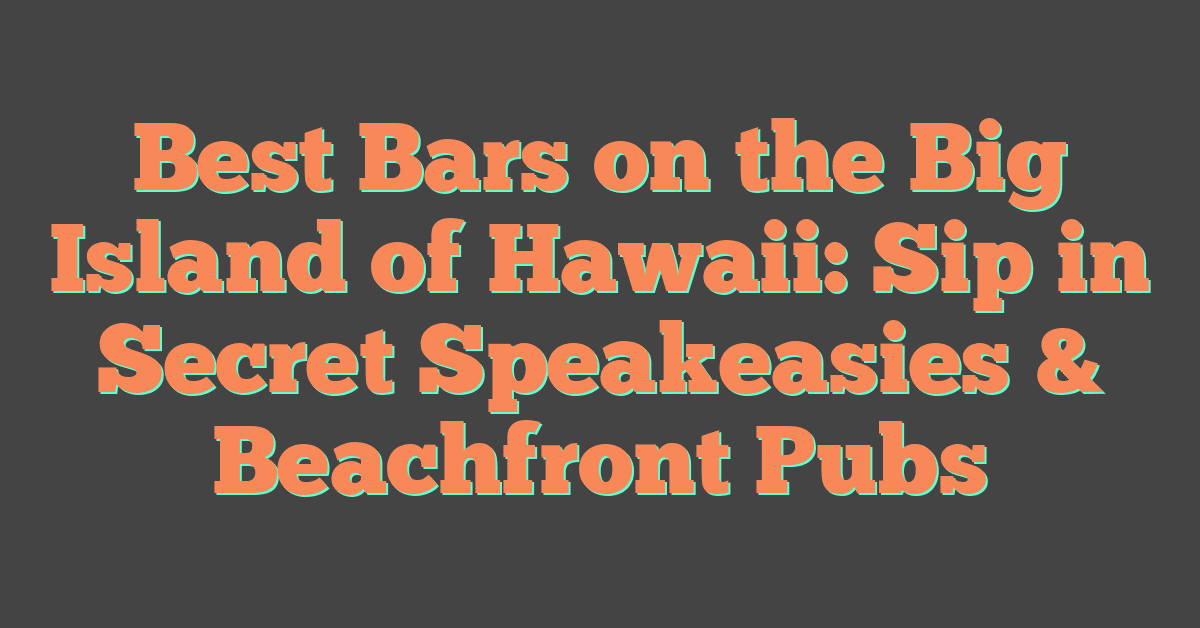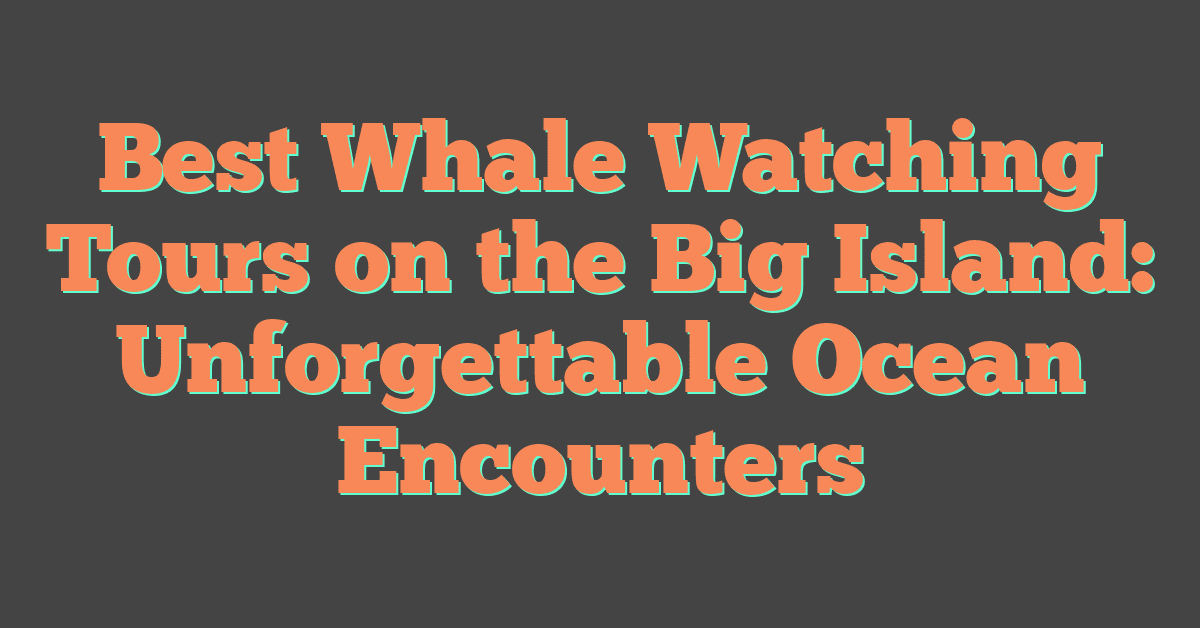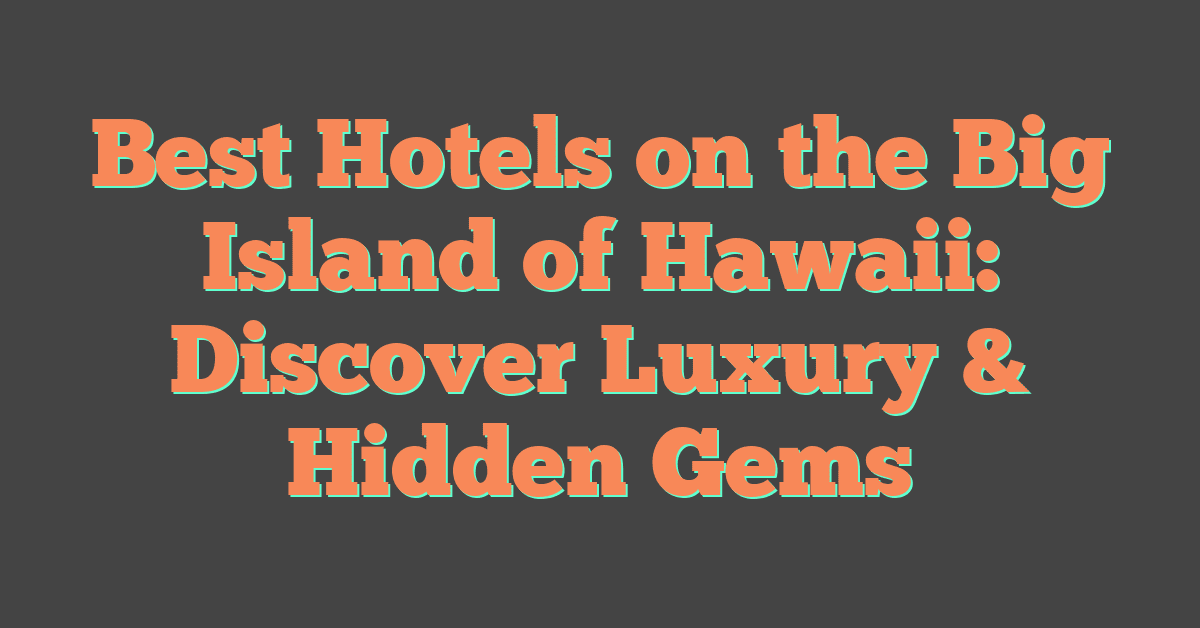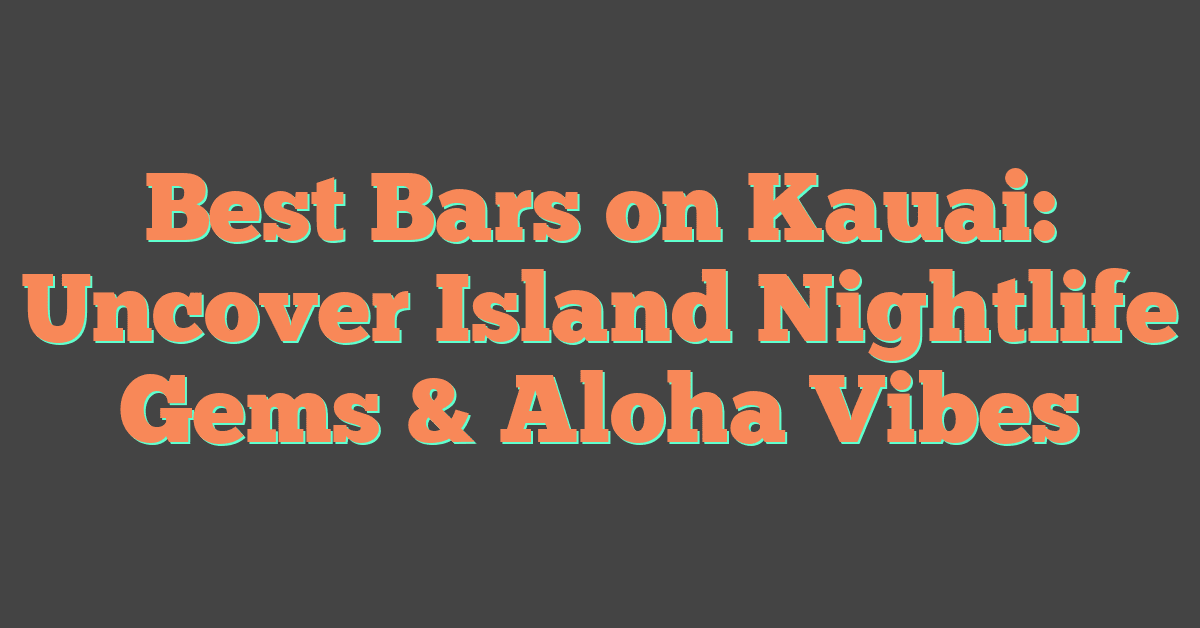Every year, I get excited for the Honolulu Festival. This event is one of the best ways to see Hawaii’s rich mix of cultures, artists, and traditions from across the Pacific.

By joining the Honolulu Festival, I watch traditional dances, taste global foods, and meet performers from places like Japan, Australia, and Korea.
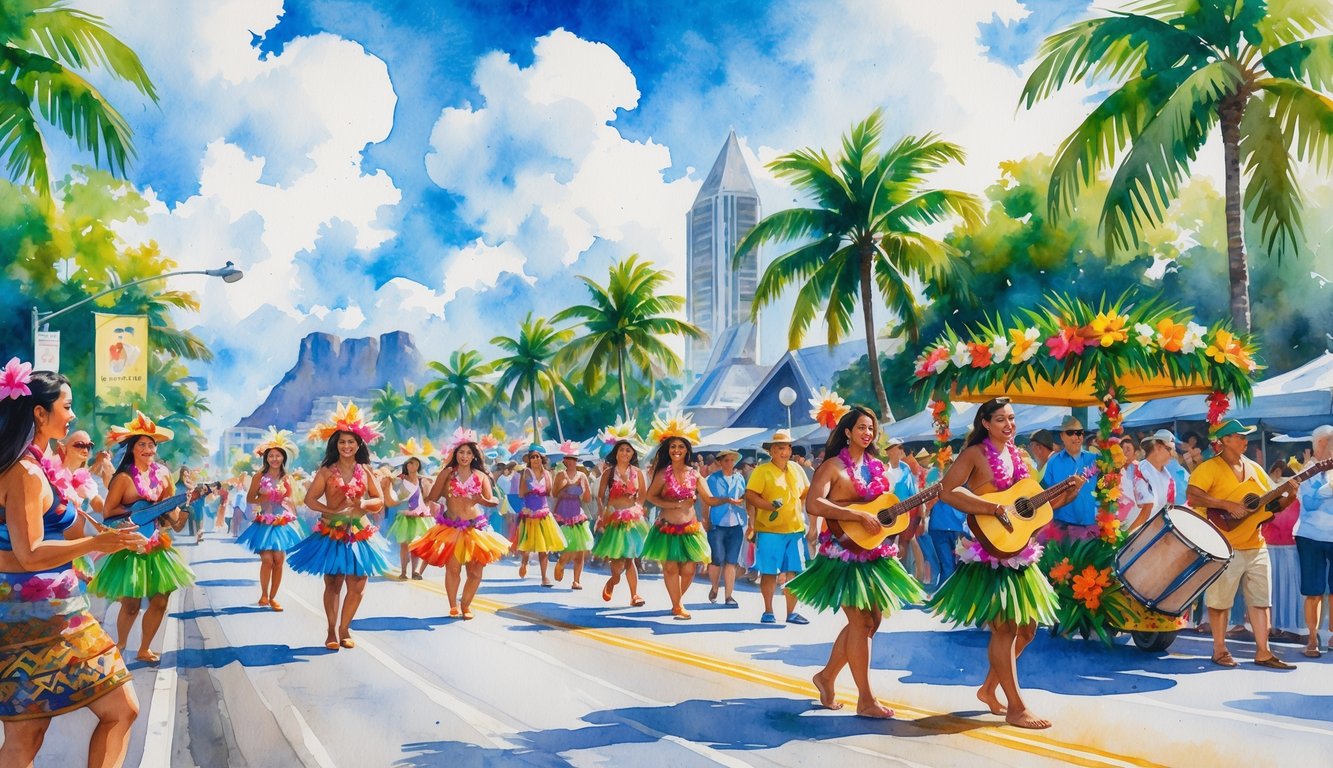
The festival is more than just a party in Honolulu—it’s a true cultural event. I love watching the lively parades and checking out the arts and crafts that celebrate not just Hawaiian heritage, but also our ties to the whole Pacific region.
Each year, I leave with a deeper understanding of what makes Honolulu’s community so special. If you want to experience the spirit of Hawaii, this is where you’ll feel it most.
With activities for families, food lovers, and anyone who enjoys music or dance, the festival has something for everyone. The fun, friendly atmosphere makes me want to come back again and again.
For more info, you can learn about the event’s highlights and activities at this detailed Honolulu Festival guide.
What Is the Honolulu Festival?
Each year, I watch the Honolulu Festival turn Waikiki into a vibrant celebration of cultural unity and Pacific harmony. The event brings together people from Hawaii, Japan, the Asia-Pacific region, and more to share music, dance, art, and food.
The Significance of the Honolulu Festival
The Honolulu Festival stands out as Hawaii’s premier cultural event. I love how it highlights the spirit of unity between all guests and participants.
Groups from places like Japan, Korea, the Philippines, Tahiti, Australia, and the United States come together to share their traditions. This festival helps me appreciate how cultural diversity brings people closer.
Traditional dances, parades, and music fill Waikiki, creating an energetic, friendly environment. The fireworks show over Waikiki Beach is especially memorable.
It feels special to witness hula performances and Japanese taiko drumming side by side, as these traditions blend to foster respect among cultures. At its heart, the festival allows me to learn about my neighbors both near and far.
This gathering creates a welcoming space where Pacific harmony and understanding are more than just ideas—they’re reality.
History and Origins
The Honolulu Festival began in 1995. Since then, it has become a major event in Hawaii’s calendar.
Organizers started it to encourage friendship and cultural exchange between Hawaii and countries in the Pacific Rim. In the early years, most performances focused on Hawaii and Japan.
Over time, groups from other Asia-Pacific regions joined, making the festival even richer. Now, people from China, Korea, Australia, and many Pacific islands take part, too.
This long history means the festival honors both ancient Hawaiian traditions and newer influences. Every year, returning guests and new visitors join in to create new memories.
Mission and Core Values
For me, the most important part of the Honolulu Festival is its mission and values. The festival promotes cultural unity, understanding, and cooperation among people of different backgrounds.
The main aims are:
- Fostering friendship between Hawaii and the Asia-Pacific region
- Showing the beauty of cultural diversity
- Creating opportunities for learning and sharing traditions
- Encouraging peace and economic cooperation
Every activity and event supports these values. Whether I watch a parade, visit a food fair, or join a craft demonstration, I see the focus on unity and respect.
When and Where the Honolulu Festival Takes Place
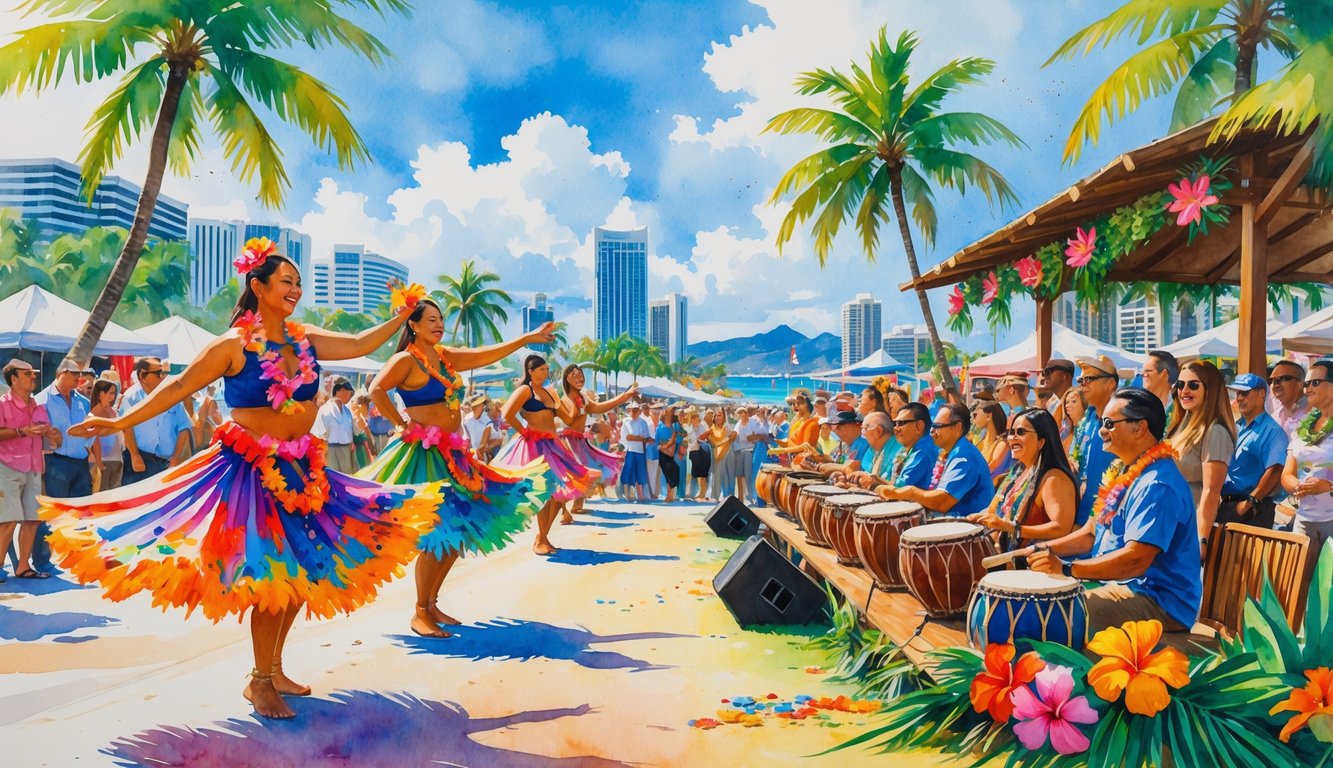
The Honolulu Festival happens every year and brings together many cultures through music, dancing, food, and special shows. Most activities and shows take place near the heart of Honolulu, and the festival features a big parade on one of Waikiki’s most famous streets.
Annual Schedule and Timing
The Honolulu Festival happens once a year, usually during the early part of March. In 2025, it takes place over the weekend of March 8–9.
Events begin on Saturday and continue into Sunday, with a packed schedule of performances, cultural displays, and fun workshops. Festival organizers set specific hours for each day, and most activities happen during daylight and early evening.
Saturday often focuses on performances and indoor exhibitions. Sunday brings outdoor shows and the big parade.
Some activities might start earlier in the day and last into the evening. Since many things happen at the same time, I check the official schedule ahead of my visit.
It helps me plan which shows I want to see the most. Find the most up-to-date timing on the Honolulu Festival page.
Key Venues in Honolulu
Most festival events happen around Waikiki and Honolulu’s city center. The main venue is the Hawaiʻi Convention Center, where I watch performances, art exhibits, and cultural workshops.
Admission is usually needed for some sections of the center. Other large event areas include Waikiki Beach Walk and areas close to Ala Moana Beach Park.
These spots are easy to reach by foot or public transport. They’re close to major hotels, shopping centers, and restaurants, which makes attending the festival very convenient.
Local parks, hotels, and shopping streets also host pop-up performances and displays. This spreads the energy of the festival across Waikiki and into central Honolulu.
Check the official festival website for exact locations each year at the Honolulu Festival event guide.
Parade Route and Main Locations
The closing parade is one of my favorite parts of the festival. It takes place on Kalakaua Avenue, the main road running through Waikiki.
I like to grab a spot early since the sidewalks fill up fast. The parade usually begins at Saratoga Road and continues down Kalakaua Avenue until it reaches Queen Kapiolani Park.
Along the way, I watch performers, dancers, and drummers from Hawaii, Japan, and around the Pacific Rim. Colorful floats and music turn the street into a lively party.
The parade route is close to Waikiki Beach and major landmarks like Waikiki Beach Walk and famous hotels. Watching the parade with Diamond Head in the background creates a truly special setting.
For visitors who want to see the best views, I recommend finding a spot near Waikiki Beach or the intersection with Ala Moana Boulevard. Parade maps and times appear on the Honolulu Festival event schedule.
Experiencing the Grand Parade
The Grand Parade is the biggest and most exciting event at the Honolulu Festival. I watch performers, floats, and groups from around the world come together on the famous streets of Waikiki.
It’s a lively celebration where I see unique traditions and enjoy a fun, friendly crowd.
Highlights of the Grand Parade
When I visit the Grand Parade, I notice it always takes place along Kalakaua Avenue in Waikiki. The streets fill up early with people waiting for the colorful parades and shows.
The energy is high, with music, dance, and cheering. The parade usually happens in the evening.
In 2025, it’s set for March 9, and it runs from about 4:30 PM to 8:00 PM. The event is free, so I don’t need tickets or special passes to join in.
After the parade, I watch a fireworks show on Waikiki Beach, which is a perfect ending to the night. For more information about the event schedule and must-see moments, I check the official Honolulu Festival Grand Parade details.
Colorful Floats and Costumes
The thing I love most are the colorful floats and costumes. Every float shines with flowers, lights, and bright fabrics.
Some floats display images or themes from Pacific cultures. People on the floats wave and toss small souvenirs or candies to the crowd.
Many groups wear traditional outfits that reflect their heritage, from hula skirts to kimonos and other festival attire. Performers dance, play drums, or sing as they go by.
The costumes and floats make for great photos, so I always bring my camera or phone. Sitting or standing close to the curb gives me the best view of the parade details as they pass by.
Floats and Parade Participants
The Grand Parade features many different groups, including school bands, community clubs, and international performers. Some participants travel from other countries just to be part of this event.
I see hula dancers, taiko drummers, and even groups from Japan, Australia, and the mainland U.S. A list of common parade participants includes:
- Local schools
- Cultural organizations
- International groups
- Dance teams
- Marching bands
Each group shares their custom songs, dances, and traditions. The mix of cultures makes the parade diverse and exciting.
I enjoy chatting with other spectators and learning about the performers. To discover more about the variety of groups and full experience, I visit Honolulu Festival Parade Details.
Cultural Performances and Art
I see and hear many forms of art and music at the Honolulu Festival. This festival brings together dance, drumming, painting, and live music rooted in the Pacific Rim and Hawaiian cultures.
Traditional Dance Performances
When I watch the traditional dance performances, I feel like I’m connecting to Hawaii’s deep history and the cultures across the Pacific. Groups from Hawaii, Japan, Tahiti, Korea, and more take the stage to share their unique styles and stories.
I see graceful hula dancers moving to Hawaiian chants. There are also energetic Tahitian and Okinawan dances.
The costumes are usually bright and detailed, showing off the dancers’ culture and pride. One of my favorite things is seeing how each group puts special meaning into their moves, clothing, and music.
It’s not just for show; many of these dances celebrate special events or honor Hawaiian legends. The Honolulu Festival lets me witness these traditions up close.
Musical Acts and Taiko Drumming
Music fills the air everywhere I go during the festival. I hear both modern and traditional music styles as I walk between stages.
I never want to miss taiko drumming. The big Japanese drums sound loud and powerful.
Performers work together, hitting the drums in set patterns that shake the ground. Their teamwork stands out—they move as one, following the rhythm.
Along with taiko, musicians play old Hawaiian songs on ukuleles and guitars. Sometimes, I listen to groups from other countries and explore music I’ve never heard before.
If you enjoy different kinds of music, you’ll always find something happening at the festival’s performance stages.
Art Exhibitions and Local Artisans
The art at the Honolulu Festival isn’t just for looking; I often meet the artists themselves. Local artisans set up booths to make and sell handmade crafts, paintings, woodwork, and jewelry.
I watch traditional art demonstrations too. I’ve seen Japanese calligraphy, Hawaiian quilting, and mask carving.
Some artisans let me try their tools or teach me about their craft. Talking to the artists helps me learn how their work connects to their family and community.
Every item tells a story. If you’re curious about art from Hawaii and the wider Pacific, the festival’s art exhibitions show a wide mix of traditional and modern creations.
Popular crafts I see at the festival:
- Lauhala weaving
- Shell jewelry
- Tapa cloth
- Ceramics
- Watercolor paintings
Live Music and Hula Dances
Whenever live music flows through Waikiki during the festival, I have to stop and listen. Local bands play everything from Hawaiian classics to catchy new songs.
Hula is a big part of the entertainment. Hula dancers perform in small groups or big troupes, telling stories with their bodies and hand motions.
The movements often match the beat of live musicians playing traditional instruments. It always feels special when I see kids and adults dancing side by side.
Hula is an important part of Hawaiian culture, passed down from one generation to the next. Usually, open-air concerts and dance shows fill the evenings.
The sounds of ukuleles, drums, and Hawaiian vocals fill the night. I find that these live performances bring everyone closer together, whether you’re a local or a visitor in Hawaii.
Hands-On Activities and Cultural Workshops
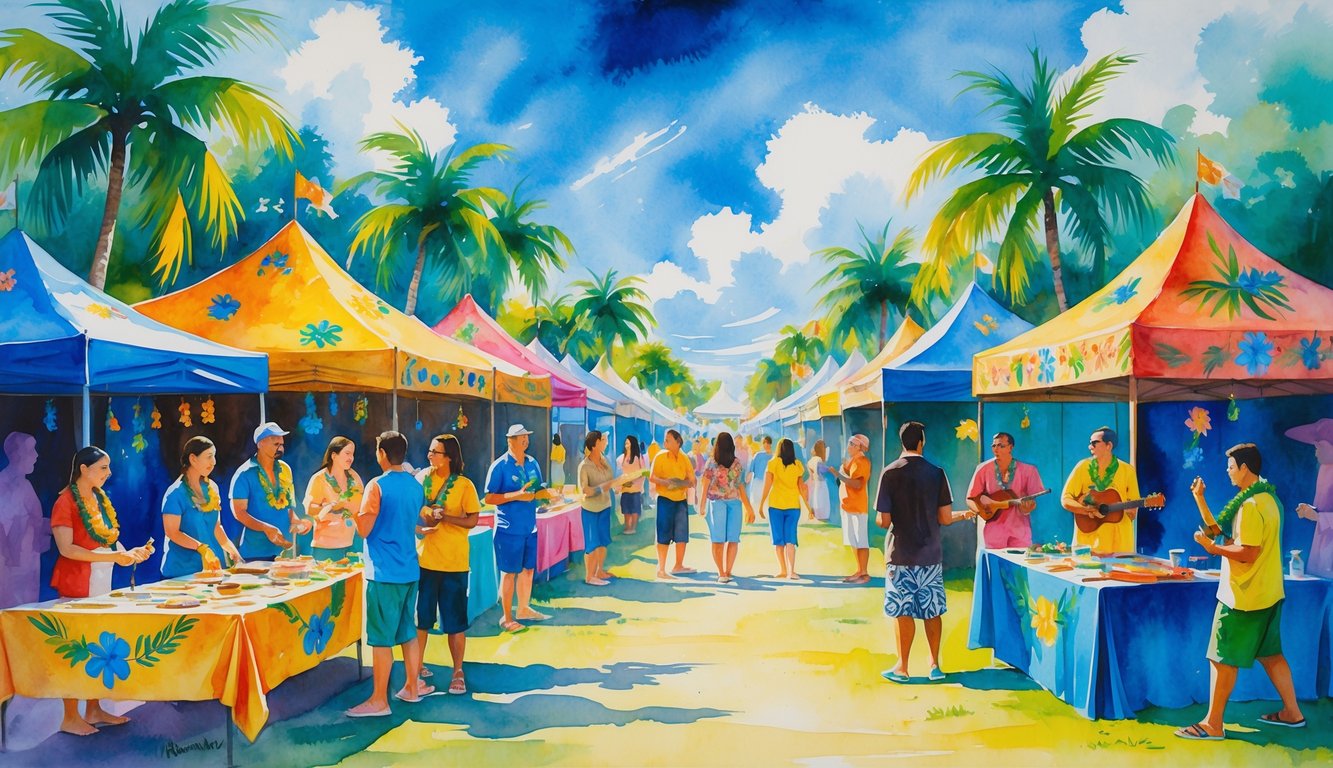
The Honolulu Festival gives me great opportunities to get involved with activities that celebrate the unique cultures around the Pacific. Local artisans and teachers guide visitors as they try making crafts or learning new art skills.
It’s a real chance to connect with tradition and bring home something you made yourself.
Lei-Making and Hawaiian Crafts
When I join the lei-making workshop, I learn how to string together fresh flowers and leaves to create a traditional Hawaiian lei. Skilled local artisans show me each step and give tips about design and flower choice.
Making my own lei helps me appreciate how much care goes into this Hawaiian symbol of welcome. Other hands-on workshops teach crafts like Hawaiian quilting, feather work, or making small wood items.
Each workshop includes a short talk about the history behind the craft. I enjoy seeing traditional art demonstrations and talking with the crafters, who explain their materials and share stories about their families and artistry.
For visitors who enjoy shopping, a craft fair offers handmade items by local artists. I find unique jewelry, prints, and home goods.
Everything connects back to the culture of Hawaii and the Pacific.
Calligraphy and Asian Arts
At the Asian arts workshops, teachers demonstrate Japanese calligraphy, or “shodo.” I try writing kanji with an ink brush and learn about the meaning of different characters.
The session highlights the importance of patience and focus in every brushstroke. I also try origami folding and learn about Chinese brush painting.
I enjoy trying each art form and bring home a few of my creations. Friendly instructors make it easy to get started, whether I’m a beginner or already familiar with these crafts.
These workshops connect cultures. People of all ages work side by side, learning from Japanese and local artists.
The experience helps me see the shared values across different art styles and traditions. Classes happen inside the festival halls at scheduled times and anyone can join in.
Find more details about the workshops and demonstrations at the Honolulu Festival 2025 page.
Interactive Activities for All Ages
The festival offers plenty of interactive activities for families and children. Organizers set up tables for kids to try crafts safely, often with help from volunteers or experts.
Kids can learn to play simple Hawaiian instruments or color sheets based on Pacific island art. Families take part in group games and join dance mini-lessons.
The atmosphere feels lively and welcoming, making it easy for everyone to participate and have fun. Demonstrations and workshops happen at different times, so I can plan my visit around what interests me most.
Hands-on activities take place at the Hawai’i Convention Center and other festival venues, as shown on the festival event schedule. Everything is set up so visitors can join in, learn, and make memories alongside local teachers and artists.
Pacific and Asia-Pacific Influences
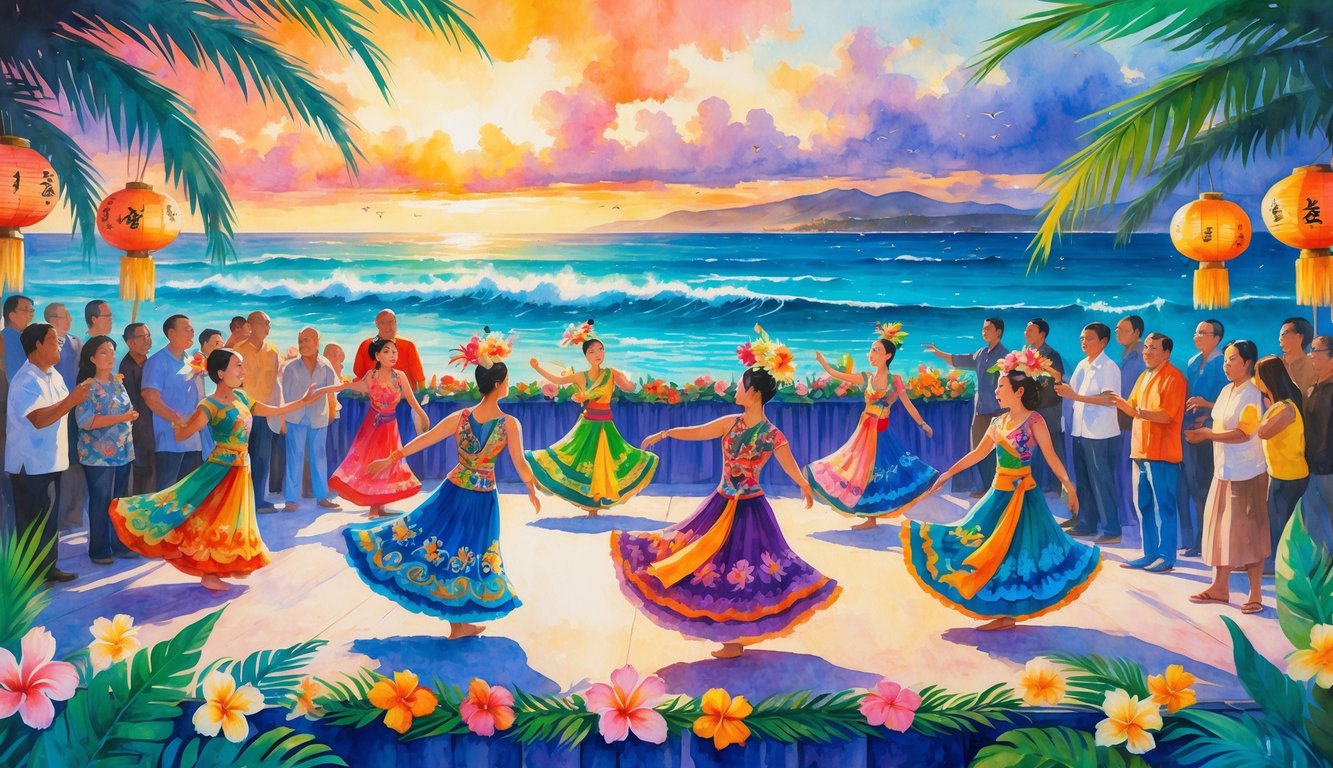
The Honolulu Festival brings together traditions and cultures from islands and countries across the Pacific and Asia-Pacific. I see unique performances, meet people from many places, and learn about their customs through hands-on activities.
International Performers and Delegations
Every year, delegations come from Japan, Australia, Tahiti, the Philippines, Taiwan (Republic of China), Korea, and the broader Pacific Rim. Their performances include taiko drumming, hula, cultural parades, and traditional dances.
I enjoy watching Japanese taiko drummers. Their energy fills the whole area.
Hawaiian hula groups share stories through graceful movements and chanting. Dancers and musicians from all over the Pacific region wear bright and colorful clothing that reflects their heritage.
Groups sometimes collaborate on stage. These international artists celebrate the region’s diversity.
Visitors can attend shows where different countries highlight both modern and traditional music. This helps me understand and enjoy Asian and Pacific cultures even more.
For a list of these cultural showcases, I check the Honolulu Festival’s program.
Cultural Exchange Activities
I find many booths and workshops that offer hands-on ways to learn about Asian and Pacific customs. Some stalls teach origami, so I can fold paper cranes and animals.
Others feature calligraphy, and Japanese artists show how to create characters using brush and ink. Cooking demonstrations introduce foods from Japan, Korea, Taiwan, and Polynesia.
I sample treats and learn about special ingredients. Cultural exchange goes beyond performances—I make leis, try traditional games, and speak to delegates from various countries.
By joining these activities, I feel connected to a wide circle of cultures. These exchanges help me see the unique details that shape daily life in each part of the Asia-Pacific region.
The festival encourages everyone, local or visitor, to join in and experience traditions up close. More details about these activities are available on the Honolulu Festival website.
Special Festival Events and Experiences
Honolulu Festival features stunning performances, meaningful gatherings, and delicious local flavors. I always look forward to displays of culture, music, and food that make this event unique.
Nagaoka Fireworks and Opening Ceremony
I love starting my festival weekend with the opening ceremony. This event welcomes everyone and sets a friendly, excited mood.
Performers from Hawaii, Asia, and the Pacific show off their music, hula, and traditional dances. Each act feels like a window into someone’s culture.
The Nagaoka Fireworks show is one of my favorite parts. These fireworks are famous for their bright colors and organized displays.
They come from Nagaoka, Japan, as a sign of friendship between the cities.
What to expect:
- Dancers in colorful costumes
- Groups from different countries performing
- A sky filled with spectacular fireworks by the water
The fireworks light up the night sky and bring everyone together for a magical finale. If you want a good view, arrive early and find a spot near the beach or harbor.
Friendship Gala
I always try to get tickets for the Friendship Gala. This is a special dinner where I meet people from Hawaii and across the Pacific.
The mood is cheerful, with live music, dance shows, and presentations that highlight local culture. At the Gala, I taste dishes from top Honolulu restaurants and learn about different traditions.
Chefs prepare a wide variety of foods, from poke bowls to Japanese specialties. There’s also a silent auction, with art and souvenirs made by local artists.
I enjoy chatting with attendees who have come from all over the world. Everyone is friendly, and the focus is on building friendships.
Highlights:
- Tasting foods from local chefs
- Cultural performances and music
- Meeting new friends and community leaders
Local Food Stalls and Hawaiian Cuisine
Trying food at the festival is always at the top of my list. Stalls line the festival area, each offering snacks and dishes unique to Hawaii.
The smell of grilled meat, seafood, and fresh fruit fills the air. Some favorites include:
| Food | Description |
|---|---|
| Spam musubi | Rice and spam wrapped with seaweed |
| Poke bowls | Fresh cubed fish over rice with toppings |
| Malasadas | Portuguese donuts rolled in sugar |
| Shave ice | Fluffy ice covered in colorful syrup |
I always stop for a plate lunch—often a mix of teriyaki chicken, rice, and macaroni salad. There are also plenty of options for Japanese, Filipino, or Korean dishes.
Sampling different bites lets me experience just how diverse Hawaiian cuisine is. For anyone who loves good food, these stalls are worth visiting.
The festival’s food scene is a true highlight and brings people together, plate by plate.
Supporting Local Businesses and Artisans
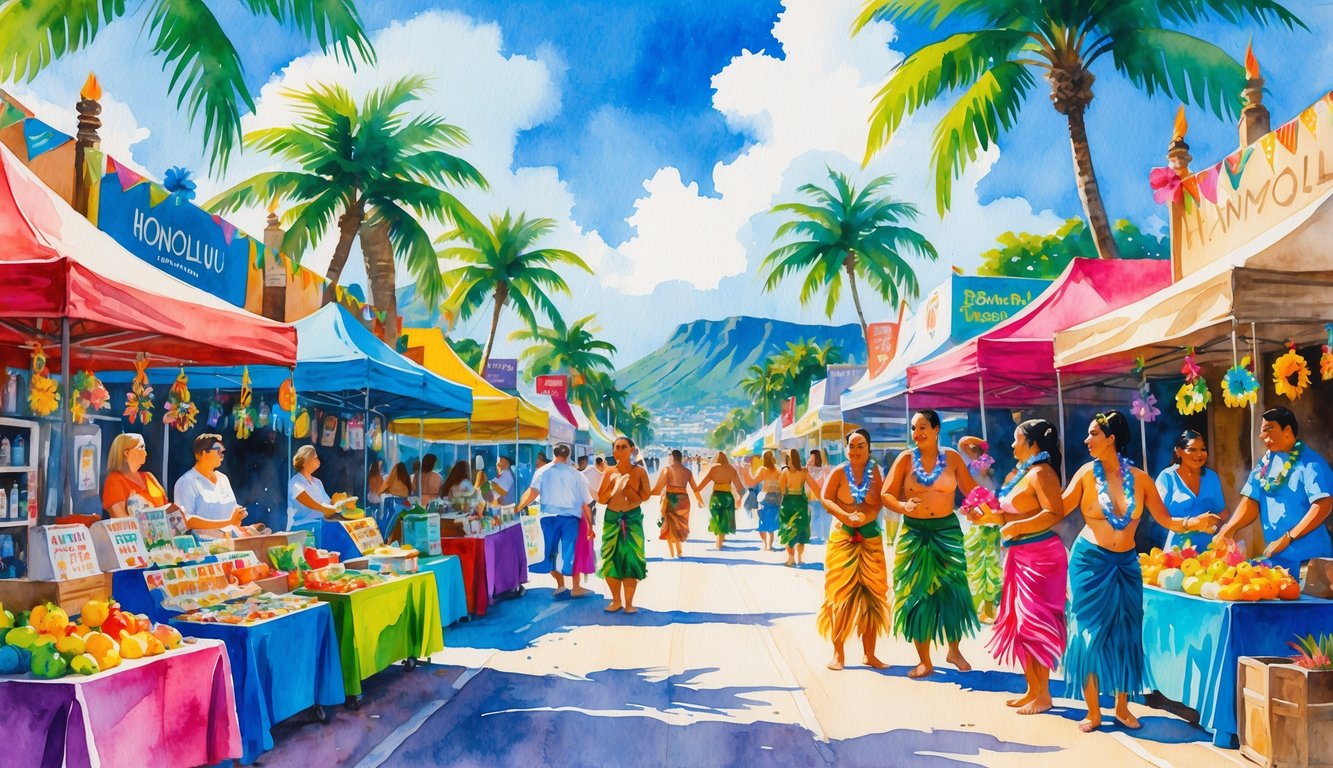
Visiting the Honolulu Festival lets me do more than just watch shows—I can make a real difference for the people who live here. Shopping and connecting with local artisans helps keep Hawaii’s culture and economy strong.
Made in Hawaii Festival Connections
When I explore the Made in Hawaii Festival, I find a huge variety of crafts, foods, and goods made by local hands. This event shows me the creativity that Hawaii is known for, from handmade jewelry to tasty island snacks.
Shopping here means I get to enjoy unique products directly from the people who made them. Many booths have artisans ready to talk with me about their work and process.
I can taste, touch, and see the pride they put into everything. The festival helps Native Hawaiian-owned companies stand out and grow.
By buying their products, I help support Hawaii artisans and keep Hawaiian traditions alive.
Local Businesses and Economic Cooperation
I see how local businesses at the Honolulu Festival work together to make the event special. Food stands, craft booths, and music performers join forces to create a lively, welcoming experience.
Many vendors offer festival-only discounts and promotions. This gives me good deals while supporting small businesses.
When I eat at a local food booth or buy gifts from nearby shops, I help my money stay in the community. This supports jobs and growth for everyone.
Events like the craft fair highlight economic cooperation by bringing over 30 vendors together. These businesses collaborate, share ideas, and reach new customers.
My choices can help the whole community thrive. More about these special opportunities is at the Honolulu Festival Craft Fair.
Other Notable Honolulu Events and Festivals
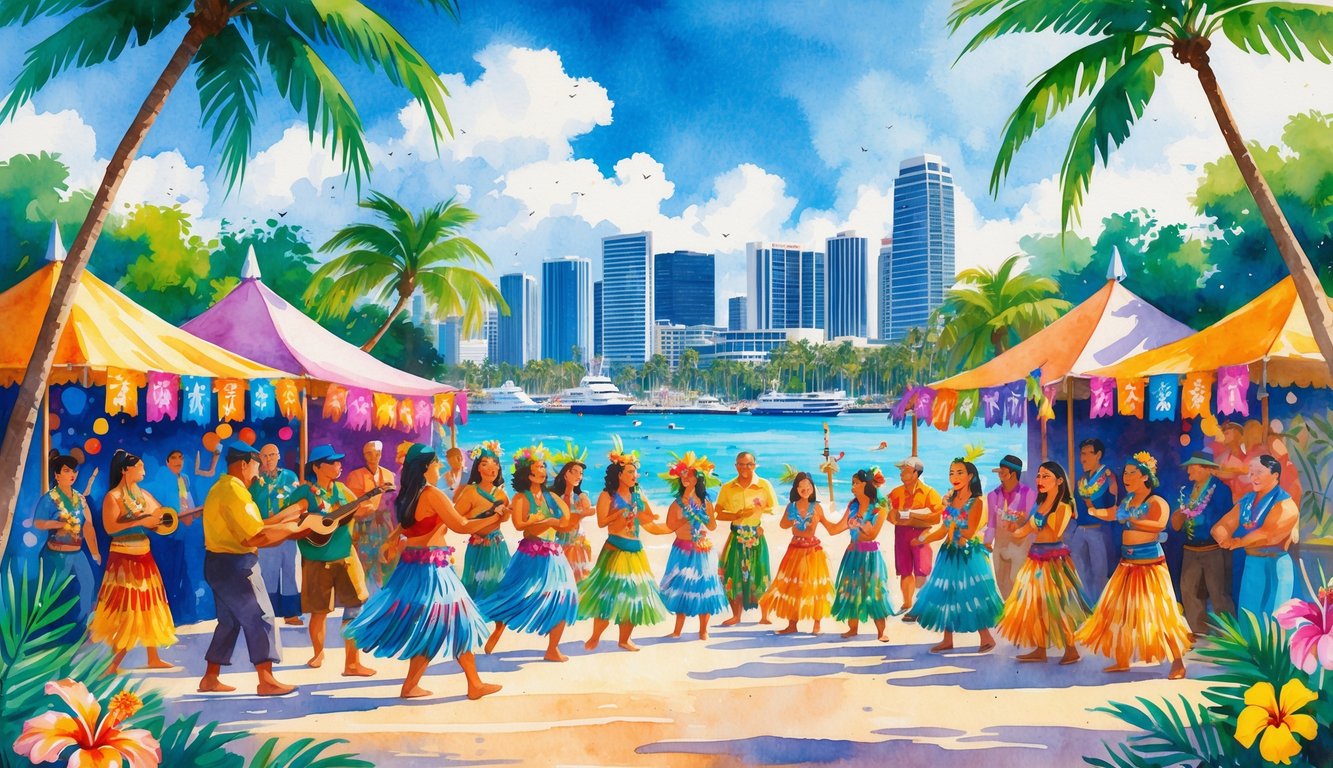
Honolulu is full of unique celebrations that showcase local music, dance, and community spirit. From parades to hula competitions and street fairs, there is almost always something happening that brings people together.
Waikiki Hoolaulea and Aloha Festival
The Aloha Festival is one of the state’s largest cultural festivals. I love how it brings everyone together for a giant celebration in Waikiki each September.
The big highlight for me is the Waikiki Hoolaulea, a block party where the streets close and fill with music, food booths, crafts, and Hawaiian performances. There is a parade with floats covered in flowers, marching bands, and hula dancers.
The entire festival celebrates Hawaiian culture, traditions, and hospitality. I recommend grabbing a lei and joining the crowd for live entertainment and great local snacks.
If you’re visiting in the fall, this event is a great way to get a feel for the real Honolulu. It is free and open to everyone, so you can just walk in and join the fun.
You can read more details at the Aloha Festivals page on Honolulu festivals.
Merrie Monarch Festival
The Merrie Monarch Festival takes place each spring in Hilo, on the Big Island. It is important to Hawaiian hula and culture, so I always pay attention from Honolulu.
This week-long event honors King David Kalakaua, who brought hula back into public life. The main draw for me is the hula competition.
The best hula groups from all over Hawaii come to compete. The performances are beautiful and show the true spirit of Hawaiian dance.
Even though the events are in Hilo, many Honolulu locals travel there or watch the live broadcasts at local venues. The festival also includes a parade, art fairs, and cultural demonstrations.
If you love dance and want to see top hula talent, the Merrie Monarch Festival is a must.
Prince Lot Hula Festival
For a pure hula experience in Honolulu, there’s nothing like the Prince Lot Hula Festival. This is the largest non-competitive hula festival on Oahu.
It usually takes place at the beautiful Moanalua Gardens, giving it a real local feeling. I enjoy seeing hula halau (groups) from around the islands share both kahiko (ancient) and auana (modern) styles.
It’s not a contest—it’s a celebration of tradition and community sharing. Admission is usually free, and the open-air setting makes it perfect for families and friends.
If you’re interested in real Hawaiian heritage, this festival is an easy way to experience it.
Additional Local Celebrations
Honolulu’s event calendar is always packed. One of my favorites is the Honolulu Night Market, which pops up in the arts district with food trucks, local crafters, music acts, and fashion shows.
If you’re active, the Honolulu Marathon draws thousands every December. Both pros and beginners run through the city and along the coast.
Smaller cultural festivals and block parties happen throughout the year. These events highlight everything from Lunar New Year celebrations in Chinatown to island music events.
I keep an eye out for street fairs, live music, and parades. They are the best way to meet locals and try new things.
For an updated list, I check out festival guides on Tourist Secrets and Holidayify.
Plan Your Honolulu Festival Experience
I want to make the most of my trip, so I check ticketing details and look for the best travel choices. I find events perfect for people of all ages.
It’s easy to enjoy the Honolulu Festival when I organize ahead of time. I make sure to take note of important information.
Tickets and Event Access
Many events at the Honolulu Festival are free. Some workshops, performances, or special exhibitions may need tickets.
I always visit the official festival site for the most current details. I check if registration is needed for any activity.
Some events, like the Grand Parade or fireworks, have VIP areas and special seating. I keep an eye on ticket release dates because some spots fill up early, especially for popular shows.
I also look out for event times and locations. Some activities take place at multiple venues, including the Hawai’i Convention Center and Waikiki Beach.
Accessibility options for visitors with disabilities are listed on the website. This helps me plan ahead and make sure everyone in my group feels welcome.
Travel Tips for Visitors
I research flights and hotel bookings early, since the Honolulu Festival attracts both locals and tourists. Staying in Waikiki is convenient because it’s close to most main events.
To get around, I use public transportation or the Waikiki trolley. This helps me avoid the hassle of parking.
If I want to see more of Honolulu outside of festival hours, I rent a bike or walk to get a better feel for the city. Packing light makes traveling easier, but I always bring comfortable shoes and sunscreen for busy festival days.
If I have time, I use the festival as a chance to explore other attractions like Diamond Head and local food spots. This turns my trip into a full Hawaiian adventure.
Family-Friendly Activities
The Honolulu Festival is a great place for families and kids. There are hands-on cultural activities, arts and crafts, and performances for younger audiences.
I check the festival schedule to find puppet shows, dance demonstrations, and art workshops that are fun for all ages. My family especially enjoys the Grand Parade with its colorful costumes and lively music.
The Nagaoka Fireworks Display is a must-see event at the end of the festival. We all remember it.
I appreciate that plenty of food booths have kid-friendly options and quiet spaces if anyone needs a break. All this helps me enjoy the festival without stress.
Spirit of Aloha and Lasting Impressions
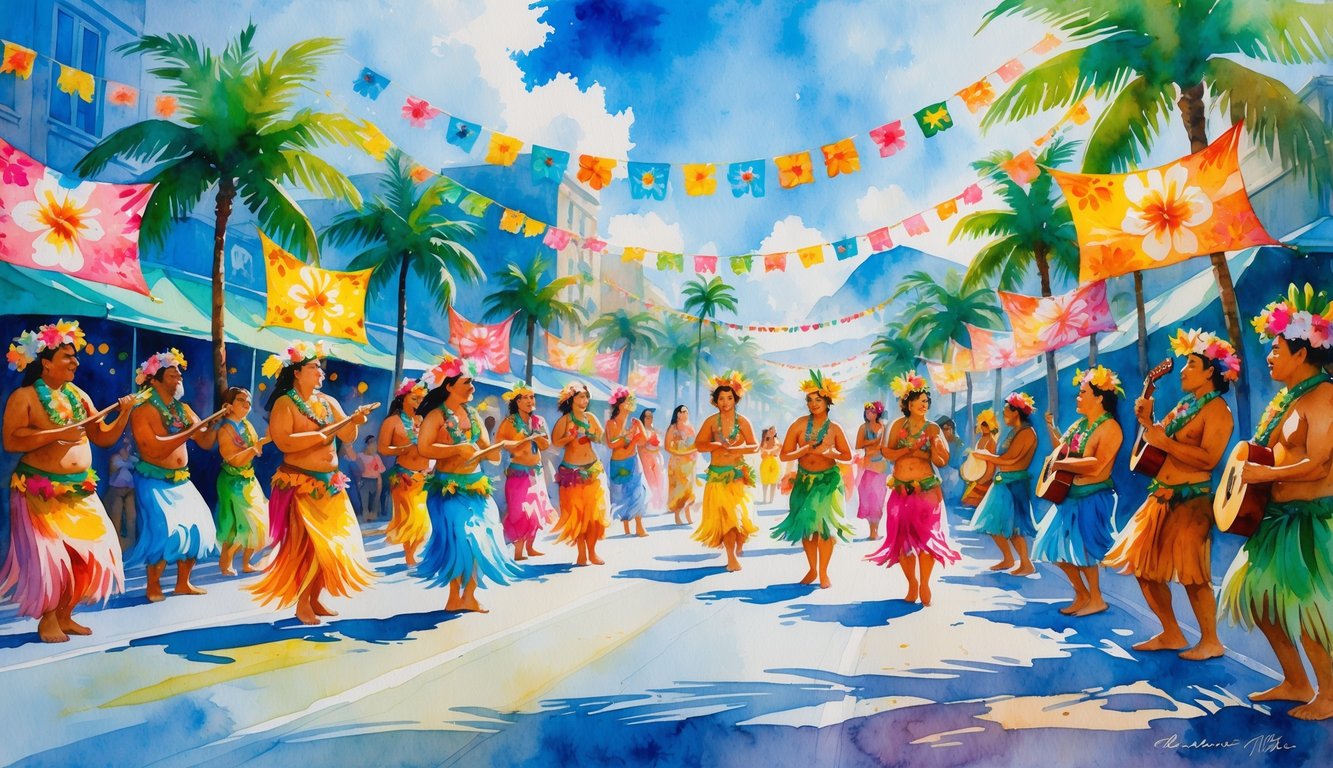
When I visit the Honolulu Festival, I feel surrounded by warmth, kindness, and togetherness. The events show the true meaning of ethnic harmony and highlight cultural heritage and shared community values.
Aloha Spirit and Cultural Traditions
For me, the Aloha Spirit is more than just a greeting. It is a way of life.
I notice how the festival celebrates unity, friendship, and respect between people of different backgrounds. Hawaiian values come to life by focusing on compassion and understanding.
During the festival, I watch traditional hula dancing, enjoy colorful parades, and listen to Hawaiian music. These are not just performances; they help people connect with Hawaii’s history and traditions.
I love wandering through the street fairs, where local crafts and foods are shared. These experiences help me learn about Hawaiian customs.
Events like the Pan-Pacific Festival show how groups from all over the Pacific come together. This makes the Aloha Spirit even stronger.
These traditions make me feel welcome and help me appreciate Honolulu’s cultural mix. The festival is full of moments where people from all walks of life join in the spirit of aloha.
Memorial Day and Community Significance
Memorial Day in Honolulu is more than just a holiday. It is an important time for the community.
Families gather, share stories, and honor those who have served. The festival features special ceremonies and displays that remind everyone of respect and remembrance.
I often join moments of silence. Locals release flowers into the ocean to pay tribute to loved ones and heroes.
During these events, the spirit of aloha shines. People support each other and make sure no one feels alone.
This caring and remembrance bring the community closer. Memorial Day connects culture, tradition, and community pride.
These acts help me understand the importance of remembering the past. They also show how much we should care for those around us.

